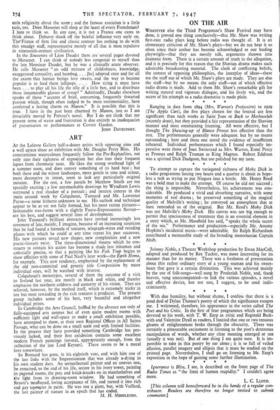ART
At the Lefevre Gallery half-a-dozen artists with opposing aims and a wall apiece share an exhibition with Mr. Douglas Percy Bliss. His conscientious watercolours frequently follow the Pre-Raphaelites, not only into their tightness of exposition but also into their frequent lapses from chromatic taste. He likes the strong overhead light of a summer noon, and does convey something of its hard heat ; but both these and the winter landscapes, more gentle in tone and colour, more decorative in intent, seem to lack any particularly original mission. For the rest, a few pastels by Matthew Smith are not specially exciting ; a few unremarkable drawings by Wyndham Lewis surround a real shocker of a portrait and interest centres in the main around work by Colquhoun, portrait; and Mr. Lawrence Payne-,-a name hitherto unknown to me. His outlook and technique appear to be as yet not fully formed, but his most recent pictures— fashionable tree-forms with a slightly Fauve-Expressionist flavour— are his best, and suggest several lines of development.
John Tunnard's brilliant abstracts have invited increasingly less comment of late, mainly, I imagine, because of an increasing suspicion that he had found a formula of textures, telegraph-wires and receding planes with which he could at any time repeat his past successes. His new pictures reveal new shapes, new complexities and a new poetic-literary twist. The three-dimensional theatre which he con- structs to contain his action has become a shade less inhuman and celestially precise so that a painting like his Fish Trap begins to show affinities with some of Paul Nash's later work—the Earth Home, for example. This new tendency,. emphasised by the replacement of the old non-committal and generic title Composition by more individual ones, will be watched with interest. Colquhoun's monotypes, several of them the outcome of a visit ito Ireland last year, are mostly in black and white, and thereby emphasise the northern coldness and austerity of his vision. They are relieved, however, by the method itself, which is extremely tricky in use but most rewarding in the rich textures it produces. The present group includes some of his best, very beautiful and altogether individual prints. In Cambridge the Arts Council, baffled by the absence not only of gully-equipped arts centres but of even quite modest rooms with sufficient light and wall-space to make a small exhibition possible, have attempted to show, at their own Regional Offices in All Saints Passage, what can be done on a small scale and with limited facilities. In the process they have provided something Cambridge has pre- viously lacked, and their first exhibition contains some excellent modern French paintings (several, appropriately enough, from the collection of the late Lord Keynes). There seems to be a moral here somewhere.
So Bonnard has gone, in his eightieth year, and with him one of the last links with the Impressionism that was already a-dying in tis own student days. An unintellectual painter and an uneven one, he remained, to the end of his life, secure in his ivory tower, painting its papered rooms, the pots and knick-knacks on its mantleshelms and the light from its drawing-room window. He had something of Renoir's unaffected, loving acceptance of life, and turned it into rich and gay tapestries in paint. He was not a giant, but, with Vuillard, the last painter of stature in an epoch that has ended.
M. H. MIDDLETON.


































 Previous page
Previous page